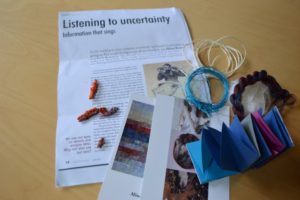 Meg’s Weaver to Weaver real mail inspiration project has ignited a sense of wonder and delight. I just received a package from weaver Cally in Scotland which has provided a little peep into another’s creative world beyond what I see on the online screen. Also included, intriguingly, is an article from the Royal Statistical Society, Listening to Uncertainty (Brown and Bearman, 2012) which advocates making data sing and using our ears as well as our eyes to see, interpret and absorb data. This has always interested me. I see our senses being used unevenly with the intensity of straight email and software use on screens. I’m sure I’m loosing my speaking words because I spend so much time typing and composing emails. Getting better at that and leaving speaking behind.
Meg’s Weaver to Weaver real mail inspiration project has ignited a sense of wonder and delight. I just received a package from weaver Cally in Scotland which has provided a little peep into another’s creative world beyond what I see on the online screen. Also included, intriguingly, is an article from the Royal Statistical Society, Listening to Uncertainty (Brown and Bearman, 2012) which advocates making data sing and using our ears as well as our eyes to see, interpret and absorb data. This has always interested me. I see our senses being used unevenly with the intensity of straight email and software use on screens. I’m sure I’m loosing my speaking words because I spend so much time typing and composing emails. Getting better at that and leaving speaking behind.
With my own packets to Julie and Alicja I wanted to include some music too but knew that it would mean a USB stick for the computer which took away from the non-virtual idea of the project. Music and what makes me feel like weaving and working away at creative projects is a deep part of my inspirational kick off point. Hearing interesting data may do the same.
Hearing data isn’t new and Brown and Bearman remind us that we use it for analysis and diagnostic tasks like accessing a car engine or where a wall is hollow. The question is: How could we use the sound of inspirational data for design in weaving when our focus in design sees to fall with imagery translated to weave? What would that process look and feel like? Perhaps I don’t have to hear the data but work out a visual weave way of designing the data within threads. Name weaves have always been popular by allocating a block or shaft to a letter then designing the weave structure but is there a way to use raw data (compiled in a CSV file) to develop a textile idea or replication of the data which can be ‘read’ by others. The fact that this approach isn’t seen except when using music as inspiration or with Fibonacci type mathematics probably means it’s not a friendly way of designing…but interesting to ponder and play with anyway.
Links
Weaving with number patterns is well known and this article on Kente cloth patterns is an interesting starter.
Symmetries of Culture: Theory and Practice of Plane Pattern Analysis is a great book on the importance of symmetry to culture and human understanding of our world. Great images of pattern. Could follow up with Symmetry Comes of Age: The Role of Pattern in Culture
which is a collection of essays but I like Symmetries of Culture much more.
The Sonification Handbook – for really going deeper…deeper.
Thanks Cally for starting a fire!

Leave a Reply